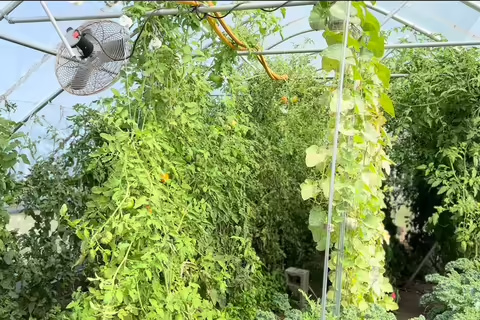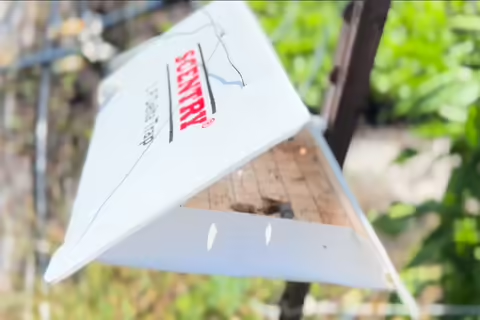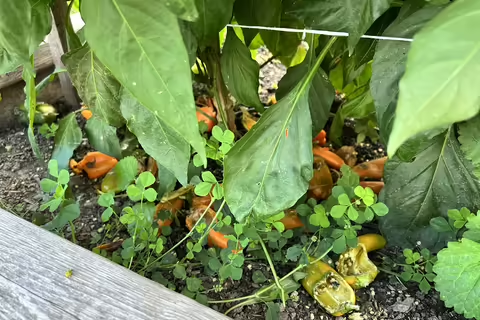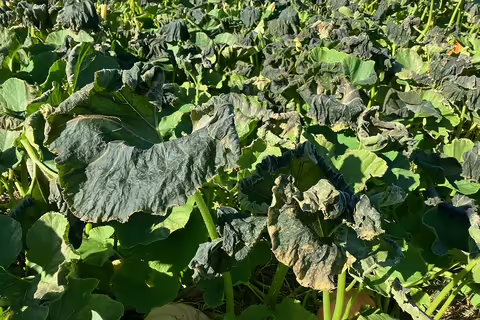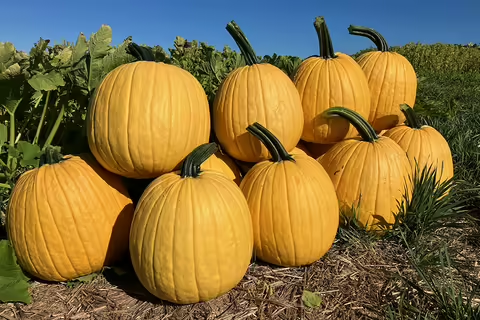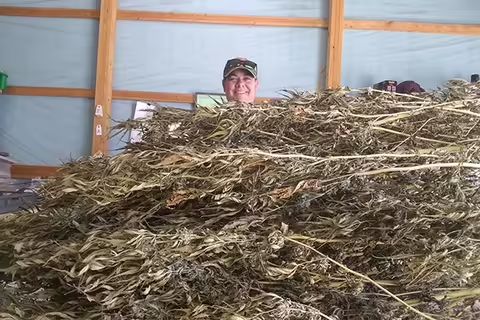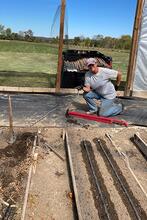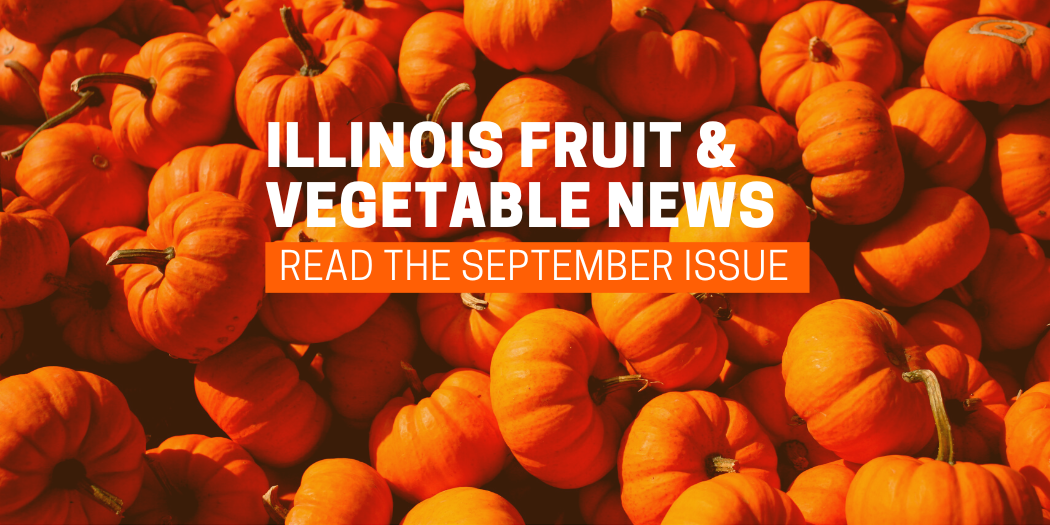
South Suburban Cook Urban Agriculture Demonstration and Research Site Regional Report
The outdoor growing season is ending over the next several weeks at SoSuCo. We are clearing out our high tunnel tomatoes to prepare for winter crop planting through mid-October. We have been harvesting tomatoes since the second week in June this year. There will be a research report developed based on the projects conducted at the site.
The indeterminate tomatoes in high tunnels get quickly out of control even with judicious pruning and trellising. Having a movable high tunnel would make the summer to winter transition smoother, but we must make an executive decision to pull the tomatoes in time to hit our winter plant dates. While the tunnel tomatoes are done, we will continue to harvest outdoor tomatoes until the first frost.
We have also been refining our pest monitoring surveys at SoSuCo this year. Since mid-July, we have been monitoring many caterpillar pests for moth flight using delta traps and pheromone lures. Our late August traps caught one corn ear worm, one beet army worm, and one cabbage looper while we showed no activity at our South Cook site for diamondback moth, black cutworm, brown stink bug, or squash vine borer in late August.
In my latest review of the traps, we had caught a few moths of all species except squash vine borer or brown stink bug. These low numbers could be attributed to late emergence this season mixed with the geographical uniqueness of the SoSuCo site. Even so, we have not had terrible pest pressure this year from insects.
I am still seeing imported cabbage worm flight and monitoring damage then spraying Bt to keep our fall Brassica plantings at a high harvest quality.
Although insects have not been a huge pest this year at SoSuCo, we continue to have a decent amount of pressure from meadow voles outdoors. Damage to peppers have been significant this year in our raised beds. While we trap many of the voles, our use of landscape fabric and tarps for weed pressure also creates a wonderful hiding spot for voles. We will continue to study better solutions for keeping weed pressure down, while not creating hiding locations for meadow voles.
Be sure to stay connected to the Urban Ag Connect vlog series for other updates related to SoSuCo.
Zack Grant (708-679-6889; zgrant2@illinois.edu)
Southwestern Illinois near Waterloo Regional Report
Now that fall is here, we have also had some very fall-like weather to go with it. We had a few hot days in September, but overall temperatures have been very pleasant with highs in the 70s and lows in the 50s many days. We have been very dry and missed some of the rain chances that had passed through only getting a few tenths if anything. Currently, there is no rain in sight for the near future, but lots of sun and more highs in the 70s.
This week, we have had some cool mornings with lows dipping down into the 40s. I could see signs of a first very light frost from lows on the morning of September 28. On the rolling hills of our pumpkin fields at home, you could see the leaves frosted in the low-lying parts of the field. This is the earliest I remember in the last 17 years of pumpkin growing that we've seen any frost injury. Last year, we saw damage around October 8, and I thought that was early! Fortunately, it was only the upper leaves that were damaged and I did not see any damage to fruit. We have a few more nights of 40s predicted, so I hope we don’t get any more frost for now.
Out in the field, we are well into apple and pumpkin harvest. I, personally, have had the best fruit set on apples I have ever had, actually a little too good. I did not get them thinned down quite like I would like, so size was smaller, but they are very good. Jonathans are picked, and we're just now picking Golden Delicious and Pixie Crunch. I also have Gold Rush but I will let them hang for another few weeks if I can.
Pumpkins are in full swing, with local markets very busy. The pumpkin crop for me is a little late due to drought conditions we had in July, but they rebounded quite well.
- Most of August and September have been moderately cool, which pumpkins really love.
- Pumpkins size and fruit quality is very good with these cooler temperatures, and I have some of the largest pumpkins I have ever had.
- The dry weather has been good for harvest and reducing fruit rots.
- We have been monitoring for melon worms in pumpkins, and, fortunately, we have not found any in the traps or in field.
I have tried a few new pumpkin varieties this year. One I’ll mention now is Lemonade. This Harris Moran variety is new to the market. I really love its consistency and size, and it yields very well. It is a C. pepo type (Jack O’Lantern) fruit, and it eventually will turn from pale yellow/off-white to a light, golden yellow when mature. Not all consumers are ready for a yellow pumpkin, but many love how it stands out or complements other colors in a mixed display.
Hopefully the weather continues to cooperate especially with some beautiful weekends, when so many people get out and visit on farm stand, fall activities and of course buy pumpkins.
Top photo: Frosted pumpkin leaves in low lying areas from the morning of 9/28/2022. Photo: N. Johanning
Nathan Johanning (618-939-3434; njohann@illinois.edu)
Dixon Springs Ag Center Regional Report
It continues to be very dry in our part of the state, and temperatures have been typical for this time of year. With the continued lack of moisture, irrigation will continue to be important for our perennial small fruit crops, especially blueberries, that are setting the fruit buds for next year’s crop.
Plasticulture strawberry transplants have been set, and while they are receiving irrigation from the drip tape, nothing beats a good shower from mother nature to help get them settled into their new home. The last round of harvest from late planted sweet corn is underway.
We are in the process of removing all of the plants from one of our tunnels in preparation for the start of our next funded grant project, “Strategies for Improving Biological Control of Insect Pests for Vegetable Growers Utilizing High Tunnels.” Within this tunnel, we will be planting cover crops by October 1, and they will overwinter with termination planned for the first part of March. Tomatoes, peppers and cut flowers will be planted into the tunnel around the first week of April.
Our other in-ground raised bed high tunnel will serve as a control, and no cover crops or cut flowers will be planted into it, just tomatoes and peppers. This will be a two year project, working with Dr. Athey, and will involve insect monitoring, sampling, analyzing, and releasing. Look for continued information on this project in the coming months.
For the past two years, we have been the southernmost site involved in the Midwest Hemp Growers Database project. We have grown out a few plants of several different industrial hemp varieties, submitted samples, and taken harvest data. It seems like for the past couple of weeks we have been up to our necks in hemp, literally, as the varieties have been ready to harvest.
Bronwyn Aly (618-695-2441; baly@illinois.edu)
Mild End to the Summer and Start to Fall
Following a very warm start to summer, temperatures were milder in August and the first half of September. Average temperatures over the past month and a half are within 1 degree of normal statewide. Humidity, while still higher than the long-term average, was also much lower in August and the first half of September than in 2020 and 2021. The milder August balanced a very warm June, and the summer 2022 statewide average temperature was only 0.9 degrees above normal and the 40th warmest on record.
Mixed Bag of Rainfall: Heavy rainfall in early August brought two to three times the normal monthly rainfall to the Effingham-Olney and Freeport areas. Meanwhile, a large part of western Illinois was very dry in August and the first half of September, with some parts of Brown, Adams, and Hancock counties picking up only 0.5 inches of total rainfall for August, less than 20 percent of normal. September has brought a bit more rain to western and central Illinois, while most of far southern Illinois has remained dry. As of September 21, the US Drought Monitor showed moderate drought in parts of western and central Illinois, and pockets of abnormal dryness across the southern two-thirds of the state.
Summer 2022 was also a mixed bag for rainfall.
- June was drier than normal virtually everywhere in the state, and extremely dry in east-central Illinois.
- Meanwhile, July and August were quite a bit wetter outside of western Illinois.
- In all, most of northern and southern reaches of the state were 2 to 4 inches wetter than normal in summer 2022, while most of central Illinois was 1 to 5 inches drier than normal in summer.
- This summer was the 50th wettest on record statewide since 1895.
Outlooks: Most outlooks – from the next 7 days to the entire month of October – lean drier than normal in Illinois as we move into the heart of fall. Meanwhile, above normal temperatures are expected over the next 4 to 6 weeks; however, this does not remove the potential for an early fall freeze. The median first fall freeze date ranges from mid-October in northern and east-central Illinois to early November in far southern Illinois.
Trent Ford, Illinois State Climatologist (217-244-1330; twford@illinois.edu)
Less Seriously
Apparently, an over-zealous high school summer worker thought the tomato stakes needed to be driven two feet into the ground, but since school is back in session, they aren’t around to help remove the stakes. Don’t get me wrong, I appreciate the work ethic, but, really? The steps in removing these stakes have included: wiggling, wiggling aggressively, wetting up the soil, digging around the stakes, prying the stakes with the shovel, using the post puller, and, last but not least, chain and side by side. Injuries incurred during the extraction process ranged from splinters to sore backs to a bleeding head wound. Sometimes it takes all the tools in the arsenal to accomplish what should be a simple task. Photo by B.Aly.
Upcoming Events
Addressing Legal Farm Risks | A series of free webinars from Illinois Extension and Farm Commons designed to minimize legal risk and build resilience for Illinois farmers. Additional information can be found here.
- October 24 Business Structure Basics
- January 23 Farm Liability and Insurance Basics
University of Illinois Extension Fruit and Vegetable Specialists
Extension Educators – Local Food Systems and Small Farms
- Bronwyn Aly: Gallatin, Hamilton, Hardin, Pope, Saline, and White Counties | 618-695-2441 | baly@illinois.edu
- Katie Bell: Franklin, Jackson, Perry, Randolph, and Williamson Counties | 618-687-1727 | klbell@illinois.edu
- Sarah Farley: Lake and McHenry Counties | 847-223-8627 | sfarley@illinois.edu
- Nick Frillman: Woodford, Livingston, and McLean Counties | 309-663-8306 | frillma2@illinois.edu
- Zachary Grant: Cook County | 708-679-6889 | zgrant2@illinois.edu
- Doug Gucker: DeWitt, Macon, and Piatt Counties | 217-877-6042 | dgucker@illinois.edu
- Grace Margherio: Jackie Joyner-Kersee Center, St. Clair County | 217-244-3547 | gracem@illinois.edu
- Grant McCarty: Jo Daviess, Stephenson, and Winnebago Counties | 815-235-4125 | gmccarty@illinois.edu
- Kathryn Pereira: Cook County | 773-233-2900 | kpereira@illinois.edu
Extension Educators – Horticulture
- Chris Enroth: Henderson, Knox, McDonough, and Warren Counties | 309-837-3939 | cenroth@illinois.edu
- Richard Hentschel: DuPage, Kane, and Kendall Counties 630-584-6166 | hentschel@illinois.edu
- Andrew Holsinger: Christian, Jersey, Macoupin, and Montgomery Counties | 217-532-3941 | aholsing@illinois.edu
Extension Educators – Commercial Agriculture
- Elizabeth Wahle: Fruit and Vegetable Production | 618-344-4230 | wahle@illinois.edu
- Nathan Johanning: Madison, Monroe, and St. Clair Counties | 618-939-3434 | njohann@illinois.edu
Campus-based Extension Specialists
- Kacie Athey: Entomology | 217-244-9916 | kathey@illinois.edu
- Mohammad Babadoost: Plant Pathology | 217-333-1523 | babadoos@illinois.edu
The Illinois Fruit and Vegetable News is a production of University of Illinois Extension and provides timely, research-based information that commercial fruit & vegetable growers can apply to benefit their farming operations.
Address any questions or comments regarding this newsletter to the individual authors listed after each article or to its editors, Nathan Johanning, 618-939-3434, njohann@illinois.edu or Bronwyn Aly 618-695-2441, baly@illinois.edu.
To receive or be removed from email notification of new postings of this newsletter, contact Nathan Johanning or Bronwyn Aly.
Download this Issue
Download this issue and share with others.
